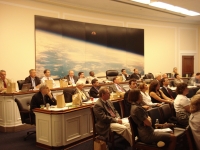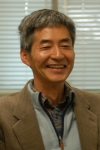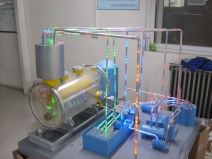Federation beyond policy difference

Speech from Masatoshi Koshiba at the meeting. from left: Hatoyama, Yosano, Saito, Kawamura, Koshiba, Naito, Suzuki(KEK), Nishioka(MHI). |
A day before Japanese cabinet reshuffling, Diet members and other senior government officials took time out from their busy schedule to attend the inaugural meeting of newly formed "Federation of Diet members to promote the realisation of ILC" with a group with representatives from all political parties in Japan: Liberal Democratic party (LDP), Democratic party of Japan (DPJ), New Komeito (NK), Social Democratic Party (SDP), The People's New Party (PNP), and Japanese Communist Party (JCP). The federation's letter of intent describes its aim the promotion of the ILC project recognising that particle physics, as a research field with no ethnical, national or ideological borders, is the essential part of the nation's basic science research strategy.
Read more...
-- Rika Takahashi |
|
 |
LCFOA goes to Washington

Attendees at the LCFOA Capitol Hill industrialisation briefing listening to Marc Ross describing the ILC TD phase plan |
The Linear Collider Forum of America (LCFOA) held an ILC industrialisation meeting and briefing for Congressional staffers on Capitol Hill on 29 July. The briefing was attended by 46 persons from universities, industry, and laboratories and Congressional staff. About half of the attendees were Congressional staffers. The objective of the briefing was to emphasise the importance of a strong industrialisation component within the Americas Regional Team's Technical Design effort, describe other potential benefits of the ILC technologies for industry and the country, and to recommend the economic and educational benefits of siting the ILC at a U.S. site during the Technical Design phase timeframe to the U.S. audience.
Read more...
-- Ken Olsen, LCFOA president |
 |
|
|
 |
From CERN
7 August 2008
CERN announces start-up date for LHC
CERN has today announced that the first attempt to circulate a beam in the Large Hadron Collider (LHC) will be made on 10 September.
Read more... |
|
From interactions
5 August 2008
Belle Discovers Three New Mesons
An international team of researchers at the High Energy Accelerator Research organization (KEK) in Tsukuba, Japan, the "Belle collaboration", has announced the discovery of three new exotic sub-atomic particles, labeled as Z_1, Z_2 and Y_b.
Read more... |
|
From interactions
4 August 2008
Tevatron Experiments Double-Team Higgs Boson
Batavia, Ill.--Scientists from the CDF and DZero collaborations at the U.S. Department of Energy's Fermilab have combined Tevatron data from the two experiments to advance the quest for the long-sought Higgs boson.
Read more... |
|
From The Economist
31 July 2008
Known and unknown unknowns
The world's largest machine is about to open for business. It will, however, only scratch the surface of the universe.
Read more... |
|
|
 |
Greetings to Kaoru and thanks to Mitsuaki

Kaoru Yokoya, new ILC-GDE Regional Director for Asia |
I am sorry to announce today that Mitsuaki Nozaki of KEK is stepping down as our Regional Director for Asia, while at the same time I am pleased to announce the appointment of Kaoru Yokoya, also of KEK, as our new Regional Director. The organisational structure of the GDE as mandated by the ILCSC and ICFA is based on rough parity in a partnership between our three regions: Asia, the Americas and Europe. Each region is represented by a Regional Director, who is part of the global GDE directorate, and also serves as the link between the GDE and regional partners.
Read more...
-- Barry Barish
Director's Corner Archive |
 |
|
|
 |
IHEP invests about 1.5 million Euros to build SCRF accelerating unit

China's Institute for High-Energy Phyics IHEP has just approved a three-year programme worth about 1.5 million Euros to build a complete accelerating unit, including a nine-cell 1.3-GHz superconducting cavity, high power coupler, HOM couplers, tuner, cryostat, low-level rf, and a 1.3-GHz high power source. IHEP started R&D on 1.3-GHz low-loss type single-cell superconducting cavities in 2005 using Chinese Ning Xia niobium, both fine and large grain, in collaboration with the ILC group of KEK. In the beginning of 2008, two Ning Xia large-grain 1.3-GHz single-cell cavities fabricated and surface treated at IHEP without electropolishing reached 40MV/m at Saito's SC laboratory at KEK. In parallel, IHEP is engaged to fabricate cryostats for XFEL at DESY. At the same time, this programme includes an upgrade of the IHEP superconducting laboratory, meaning the accelerating unit can be built and tested at IHEP. “The philosophy of this programme is to make use of the unit as a horizontal test stand for nine-cell cavities in the future, like they exist in Europe and North America,” says Jie Gao, programme leader.
|
 |
|
|
 |
Sorry JLab!
Several attentive readers have pointed out that the Cornell's Energy Recovery Linac (see last week's issue) is not the first one - in fact the free-electron laser at Jefferson Lab is the first operational energy recovered linac, with first lasing reported in 1998 and first lasing with energy recovery in 1999. The laser continues to operate and be extended. Thanks to everyone who pointed this out and please excuse the mistake. Find out more about JLab's ERL here: www.jlab.org/highlights/srferls.html
EUROTeV Reports
2008-034
The 2mrad Crossing Angle Scheme for the International Linear Collider
|
|

